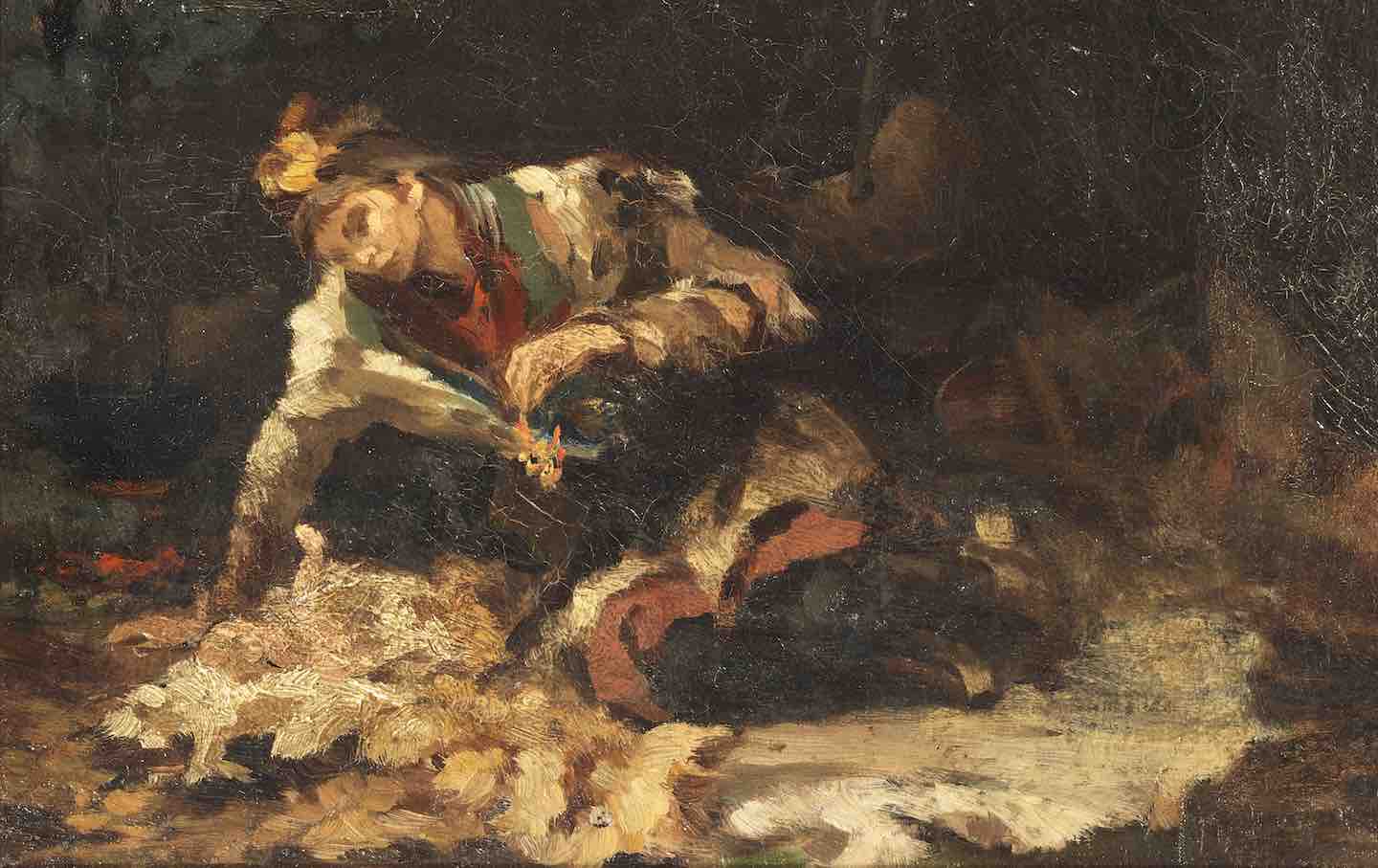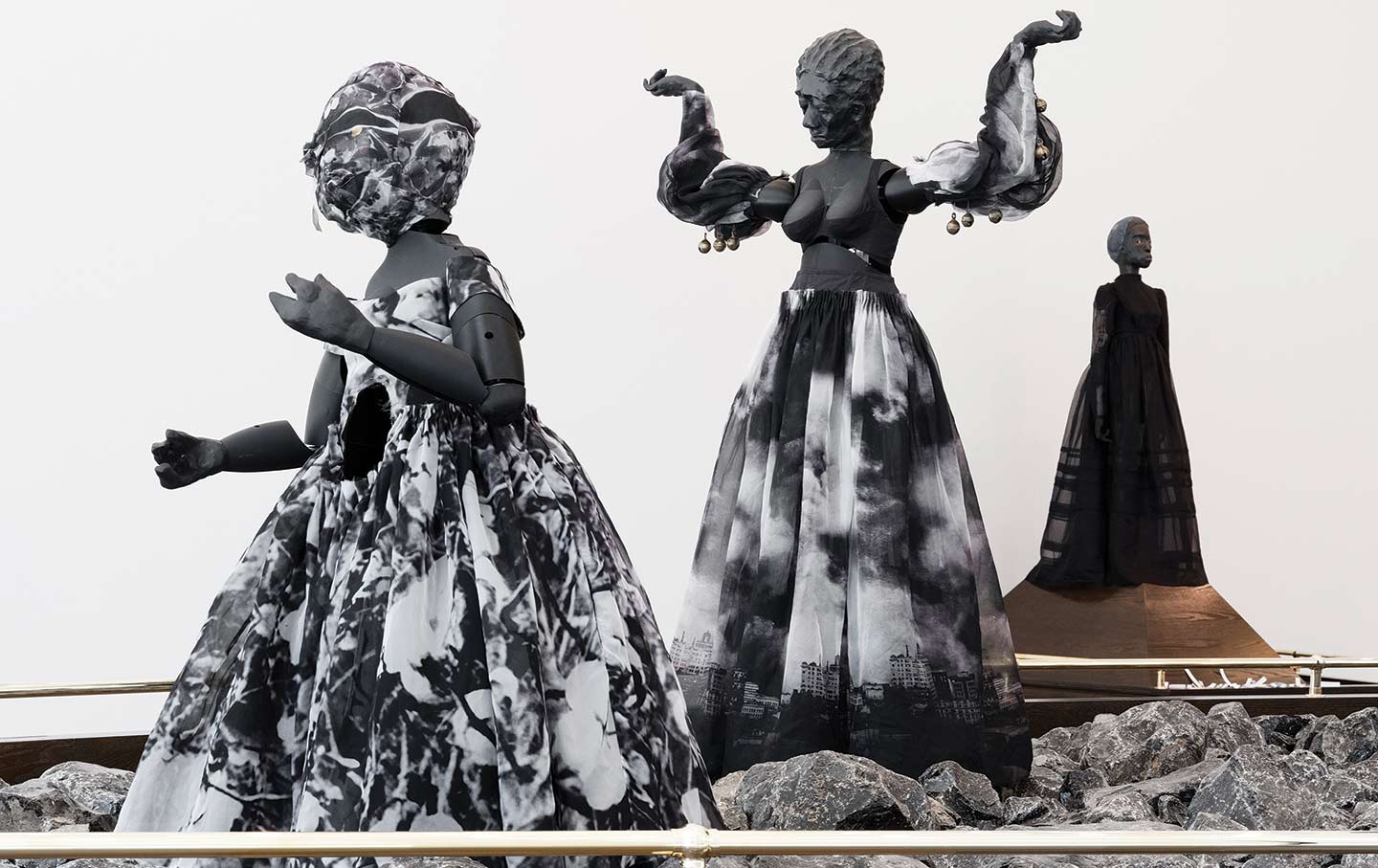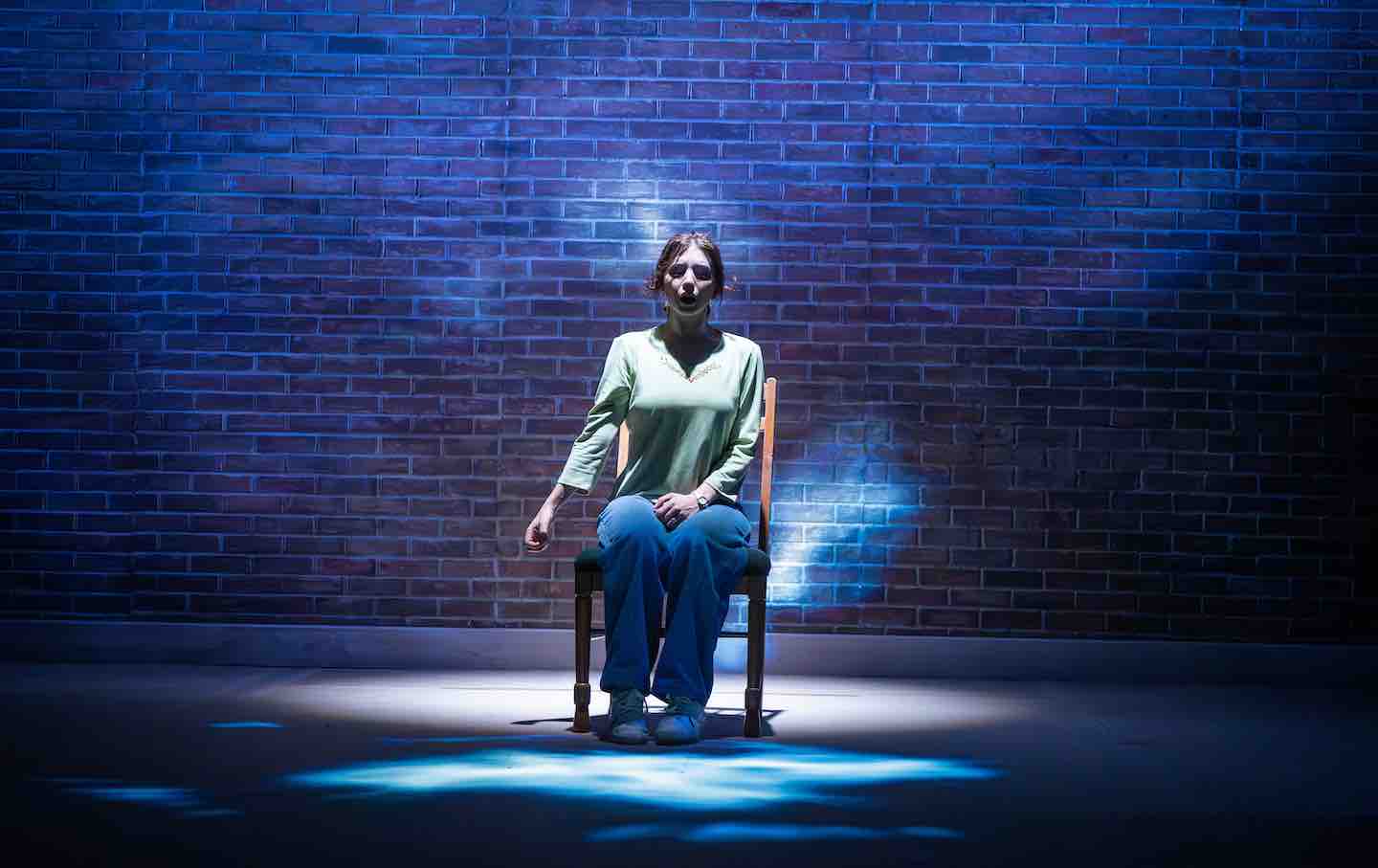A Swedish Poet Comes Face to Face With the Epic
Sámi writer Linnea Axelsson’s AEdnan uses the ancient form to critique Sweden’s historical mistreatment of its indigenous people.

Anna Nordlander, Sami Woman and her Child (1870s).
(Heritage Art / Heritage Images via Getty Images)
Like the work it describes, the subtitle of the Sámi poet Linnea Axelsson’s AEdnan: An Epic is a marvelous provocation. In her translation from the Swedish, Saskia Vogel has rendered Axelsson’s multigenerational story of a Samí family over the course of the 20th century and into the 21st in a vernacular so close to silence that it invites the readerly equivalent of straining to hear a whisper. The poem’s clean lines resemble some perpetual noon where ambiguities, like shadows at the sun’s zenith, must be compacted into such small zones that those who aren’t looking for them are likely to be fooled into thinking them nonexistent. AEdnan’s matter is the dispossession and forced assimilation of the Sámi—an Indigenous people who have traditionally lived in the north of the Scandinavian and Kola peninsulas—into Swedish society. Axelsson resists the sprawling sonority so often associated with epic poetry in favor of a tightly focused examination of the way historical tragedy reverberates in unexceptional lives: a couple named Ber-Joná and Ristin lose their child to the hazards of nomadic life in the first generation and the poem tracks the experiences of their descendants as the appropriation of their ancestral lands and Swedish prohibitions against their way of life accelerate, including the outlawing of Sámi languages and customs and the forcible removal, after the Second World War, of Sámi children to “nomad schools” meant to absorb them into the Swedish citizenry.
Books in review
Aednan: An Epic
Buy this bookIn AEdnan, the living tradition of Sámi history is resilient but unevenly available and unevenly legible and speakable. Axelsson’s practice of epic dramatizes the difficulty of telling the past under these conditions; each member of AEdnan’s chorus of Sámi voices struggles with the silences imposed by loss. Lise, one of the children taken from her family and sent to the nomad schools, has difficulty, ever after, in articulating her past to herself and to others, although Lise’s daughter, Sandra, would like nothing more than to hear her mother’s story. Axelsson imagines Sandra as a Sámi activist, part of the effort that resulted in the 2016 Girjas verdict, a rare legal victory for Indigenous people, in which the Sámi recovered fishing and hunting rights on their land in Gällivare District Court. (A Swedish Supreme Court decision in 2020 concluded further that the right to confer fishing and hunting rights would belong exclusively to the Sámi.) But Axelsson is aware that this victory, though significant, is by no means complete or a full corrective for what has been lost. In one passage in AEdnan, Lise thinks of how “the Swedish / language grew / along my thoughts,” atrophying her relationship to her dialect of Sámi. “The voice stirred,” Lise reflects uneasily, “barely perceptible / almost impossible to rouse.” The poem is, in many ways, the search for the language in which the poem can be written. “Voice” is one of the most repeated nouns in a deliberately restricted lexicon that captures what it’s like to relate to a language that seems likely to give out if depended upon to bear the weight of history.
This constrained way of grasping at a viable poetic language echoes the Samí relationship to their own history, which must, against epic’s panoramic aspirations, be pieced together from speculation and fragments. AEdnan conveys this casting around for a voice that can speak truly in an almost punishing brevity—fragmented lines that run in a narrow column down pages that stretch away from them, vast and blank, sometimes as if they were making the most of slender resources, sometimes as if they were clustered together for warmth amid a dangerous scarcity:
All the while
the Swede was damming–
and the water climbed
the hills–
Town after town
the Swede erected
around his structures–
With streets of iron
buildings of stone
Vast weighty
hard structures
The translation employs heavy stresses—“town,” “stone,” “vast”—emphasizing the way the colonizer divides up the land and weighs it down. This rhetoric reflects the progression of other Indigenous struggles, though the Sámi’s situation is also irreducible in its specificity, as is true of all conflicts lumped together under “Indigenous struggle.”
Similarly, the uses of epic forms vary with context. “Epic” is a genre of long, narrative poem that summons up, for many English-language readers, the Iliad and the Odyssey, foundational texts of the Western canon. These works have often been received as texts about how to be legible as a subject and who is eligible for subjectivity. The Iliad and the Odyssey also came to be exemplars of poetic style, distinctive, among other qualities, in their meter (dactylic hexameter) and their extended similes (the latter show up in their inheritors everywhere from Virgil to Proust). Precisely because she is interested in who gets to be a subject—who earns a “voice” and the right to speak—Axelsson moves against the lineage of Homeric poetics and its preoccupation with heroism and romantic visions of masculinity. Despite this, however, AEdnan is not anti-epic. Nor is it a mock epic, like Pushkin’s Eugene Onegin or Gwendolyn Brooks’s Annie Allen, or a style of epic that resembles the Icelandic sagas or the Finnish Kalevala.
Partly as a critique of the patriarchal, aristocratic values valorized by the official line of many epic poems, AEdnan is genuinely interested in epic’s capacity to shape a people’s sense of its own history. But while Greco-Roman epic founds its idea of personhood on a connection to glorious exploits and mythic quests, Axelsson’s epic wonders what kind of historical subjectivity is possible in the wake of the methodical, colonial destruction of Sámi language and culture:
But of our own
history not a word
was written
–
As if our
parents and we
had never existedhad never shaped
anything
To answer that question involves a tricky balancing act: Axelsson composes AEdnan in Swedish, the language of the colonizer, but turns nevertheless to the resources of Sámi literature to describe what it’s like to occupy a subject position defined as much by its losses as by its hard-won plenitude. The ambition of Axelsson’s epic is, at once, modest and unimaginably grand: to “voice” something with a reasonable assurance of being heard and understood, even if it must be done in an alien tongue.
The sense that borrowed language is both a necessary instrument and an ill-fitting coat might be a signal irony in light of the epic framing. But perhaps it isn’t, given that there are Sámi practices analogous to epic. Although the ancient epic’s movement from oral transmission to written literature parallels Sámi tradition’s enforced shift from oral relay to literature, the latter took place with radical speed—traditionally, Sámi languages had no written system. Before they became “literature” and “music,” Sámi genres centered on the practices of muitlandáidu, tale-telling, and yoik, a form of melodic, rhythmic vocalization, often compared to singing, meant to conjure the essence of a person, place, thing, or experience. So yoik constitute a kind of memory, and as a rite of passage, adolescents would receive a personal yoik—a yoik like no other—that would, throughout life and after death, summon them up for whoever yoiked them and place them with respect to the Sámi collective. Although they precede T.S. Eliot by eons, yoik could be compared to his theory of the objective correlative—the formula for an emotion concentrated in a symbolic vehicle—with one crucial difference: yoik are not symbols but enactments.
Yoik could also take on epic dimensions in the sense of calling forth, sometimes through lengthy, personal narrative, a founding myth for a people. Yoik collected by Anders Fjellner in the 19th century are of this persuasion, tracing Sámi ancestry to the sun. Fjellner gathered these Sámi myths in hopes that they would play, for the Sámi, the same part that the consolidation of disparate tales into the Kalevala had in bringing Finnish nationalism to critical mass after its publication in 1835. Although Päiven Pārne (Sons of the Sun) would not secure Sámi land rights, it would prove a valuable preservation of endangered traditions and a key text in the revival of Sámi language and political resistance in the 1970s.
One aspect of Sámi yoik’s versatility lies in its ability to convey one meaning to an audience of outsiders and another to any Sámi listeners. Axelsson’s first lines—“The voice / the cup that memory / fills”—might recall, for some, the beginning of the Iliad: “Sing, goddess, the rage of Achilles.” But this resonance is ultimately a kind of joke. The “voice” of AEdnan’s first line does the double work of the yoik, invoking the “sing, muse” of Greco-Roman epic to outsiders versed in the European inheritance of letters and, to those who know Sámi culture and literature, the Samí poet Hans Aslak Guttorm’s “voice crying in the wilderness” for a revival of oral tradition.
AEdnan is full of these twinned meanings, directness that also works as indirection, a tactic that often develops from a position of double consciousness. The capacity to say two things at once to two different audiences is one of AEdnan’s most vital strategies—not so much code-switching as code-doubling. The task Axelsson sets herself is, in itself, double: with respect to its non-Sámi readers, AEdnan chips away at an oppressive innocence; with respect to its Sámi readers, the poem “voices” in a way analogous to yoik. In service of the former aim, the poem apostrophizes:
You Nordic children
who have gone forth
so lightly
As if you were
entirely without power
without a past–
Those who have
gone before you
apparently
forgotto pack your baggage
In this moment, AEdnan shadows the baldness of direct address to the Nordic children with the subtext of Sámi experiences of nomadic travel, on the one hand, and, on the other, displacement. The poem punctures the lightness conferred by the illusion of innocence, while invoking, as if inverted in a mirror, the sudden rent in the fabric of Sámi life when children like Lise and her brother, Jon-Henrik, were sent away to the nomad schools.
Axelsson reserves her subtlety for other uses. The poem’s first voice, Ber-Joná, describes the landscape where he is herding reindeer with his doomed son, Aslat:
On a sunny spring hill
rested our
pregnant doesWe heard
heartbeats in the groundFaint
beneath the inherited
migration paths
Popular
“swipe left below to view more authors”Swipe →Aslat is not yet doomed, of course, at this early point in the poem. It’s spring, and new life is burgeoning for the reindeer and the earth alike. While the sound of heartbeats in the earth might seem like merely an apt metaphor for the seasonal renewal of life, it’s also a figure that draws on a traditional Sámi tale—never overtly relayed in the poem—about hope’s ineluctable difficulty.
As the Sámi scholar Harald Gaski narrates it, at the beginning of the world, the Great Creator buried the live heart of a 2-year-old reindeer cow at the center of the earth. Pressing an ear against the ground to listen, so the story goes, will verify whether it still pulses there. If it beats, then whatever trials the Sámi face can be solved—in light of which, there’s an extra bite to the delicately satirical moment when Lise asks her husband, a Swedish man, if he has an aversion to her “smoked heart” when she notices he’s not having seconds. Although it’s a brave and vulnerable act, to serve one’s heart up on a platter is, strangely, the path of least resistance in AEdnan; to listen for the sound of the reindeer’s heart in the earth is more challenging. Still, even this is easy next to the hard art of keeping it beating.
More from The Nation

The Art and Automatons of Kara Walker The Art and Automatons of Kara Walker
Walker’s new installation at the San Francisco Museum of Modern Art offers us visions from both the past and future.

A Snapshot of a Mother’s Life in Gaza Under Occupation A Snapshot of a Mother’s Life in Gaza Under Occupation
Khawla Ibraheem’s play Knock on the Roof examines how the Israeli military terrorizes Palestinians in their most intimate and private spaces: their homes.

Vigdis Hjorth and the Novel of Ugly Love Vigdis Hjorth and the Novel of Ugly Love
In If Only, the Norwegian novelist distills a story of romance into all its private discomfort and claustrophobia. Its intense ambivalence in regards to love feels truer to life. ...

The Dubious Return of the Brutalists The Dubious Return of the Brutalists
Why the stark 20th-century architectural style is back in vogue.

Devastating Empathy: Jules Feiffer, 1929–2025 Devastating Empathy: Jules Feiffer, 1929–2025
The cartoonist and writer proved that the deadliest skewering is informed by understanding.

The Art of Reading Like a Translator The Art of Reading Like a Translator
In The Philosophy of Translation, Damion Searls investigates the essential differences—and similarities—between the task of the translator and of the writer.


